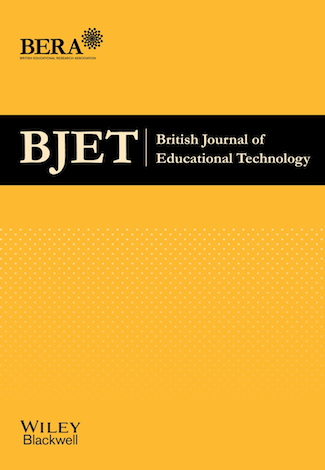
Use of three‐dimensional (3‐D) immersive virtual worlds in K‐12 and higher education settings: A review of the research
ARTICLE
Khe Foon Hew, Wing Sum Cheung
British Journal of Educational Technology Volume 41, Number 1, ISSN 0007-1013 e-ISSN 0007-1013 Publisher: Wiley
Abstract
In this paper, we review past empirical research studies on the use of three‐dimensional immersive virtual worlds in education settings such as K‐12 and higher education. Three questions guided our review: (1) How are virtual worlds (eg, Active Worlds, Second Life) used by students and teachers? (2) What types of research methods have been applied? (3) What research topics have been conducted on virtual worlds in teaching and learning, as well as their related findings? Overall, we found that virtual worlds may be utilised for the following uses: (1) communication spaces, (2) simulation of space (spatial), and (3) experiential spaces (‘acting’ on the world). Most of the studies reviewed were descriptive and conducted in polytechnic and university settings, and past virtual world research had been most frequently carried out in the media arts and health and environment disciplines. Three main research topics were found: participants' affective domain, learning outcomes and social interaction. We conclude by summarising some major findings and discussing three limitations of previous empirical studies. Several recommendations for future research related to virtual worlds in education settings are also provided.
Citation
Hew, K.F. & Cheung, W.S. (2010). Use of three‐dimensional (3‐D) immersive virtual worlds in K‐12 and higher education settings: A review of the research. British Journal of Educational Technology, 41(1), 33-55. Wiley. Retrieved August 7, 2024 from https://www.learntechlib.org/p/187503/.
Cited By
View References & Citations Map-
Fostering oral presentation competence through a virtual reality-based task for delivering feedback
Stan van Ginkel, VR Lab of the Archimedes Institute; Judith Gulikers, Harm Biemans & Omid Noroozi, Department of Education and Learning Sciences; Mila Roozen, Groningen Institute for Evolutionary Life Sciences; Tom Bos, NCOI Education Management; Richard van Tilborg & Melanie van Halteren, CoVince; Martin Mulder, Department of Education and Learning Sciences
Computers & Education Vol. 134, No. 1 (June 2019) pp. 78–97
-
How is the use of technology in education evaluated? A systematic review
Jennifer W.M. Lai & Matt Bower
Computers & Education Vol. 133, No. 1 (May 2019) pp. 27–42
-
Language Acquisition With Augmented and Virtual Reality
Hayet Bensetti-Benbader & Dennissa Brown, New Jersey City University, United States
Society for Information Technology & Teacher Education International Conference 2019 (Mar 18, 2019) pp. 1730–1734
-
Meta-theoretic Assumptions and Bibliometric Evidence Assessment on 3-D Virtual Worlds as Collaborative Learning Ecosystems
António Correia, Fernando Cassola, Diogo Azevedo, André Pinheiro, Leonel Morgado, Paulo Martins, Benjamim Fonseca & Hugo Paredes
Journal of Virtual Worlds Research Vol. 7, No. 3 (Jul 20, 2014)
-
An Australian and New Zealand scoping study on the use of 3D immersive virtual worlds in higher education
Barney Dalgarno, Mark Lee, Lauren Carlson, Sue Gregory, Belinda Tynan & Belinda Tynan
Australasian Journal of Educational Technology Vol. 27, No. 1 (Jan 01, 2011)
-
Identifying Student Profiles to Investigate Behavior during an Avatar-Based Learning Task in a Virtual Environment
Heather May Gautreau & Patricia Boechler, University of Alberta, Canada
EdMedia + Innovate Learning 2018 (Jun 25, 2018) pp. 1553–1561
-
Acquiring Software Project Specifications in a Virtual World
Vincent Ng & Zoe Tang
Electronic Journal of e-Learning Vol. 10, No. 1 (2012) pp. 120–131
-
Art Education Avatars in Action: Preparing Art Teachers for Learning and Teaching in a Virtual Age (for Special issue Digital Games and Simulations in Teacher Preparation)
Lilly Lu, Northern Illinois University, United States
Journal of Technology and Teacher Education Vol. 19, No. 3 (October 2011) pp. 287–301
These links are based on references which have been extracted automatically and may have some errors. If you see a mistake, please contact info@learntechlib.org.
